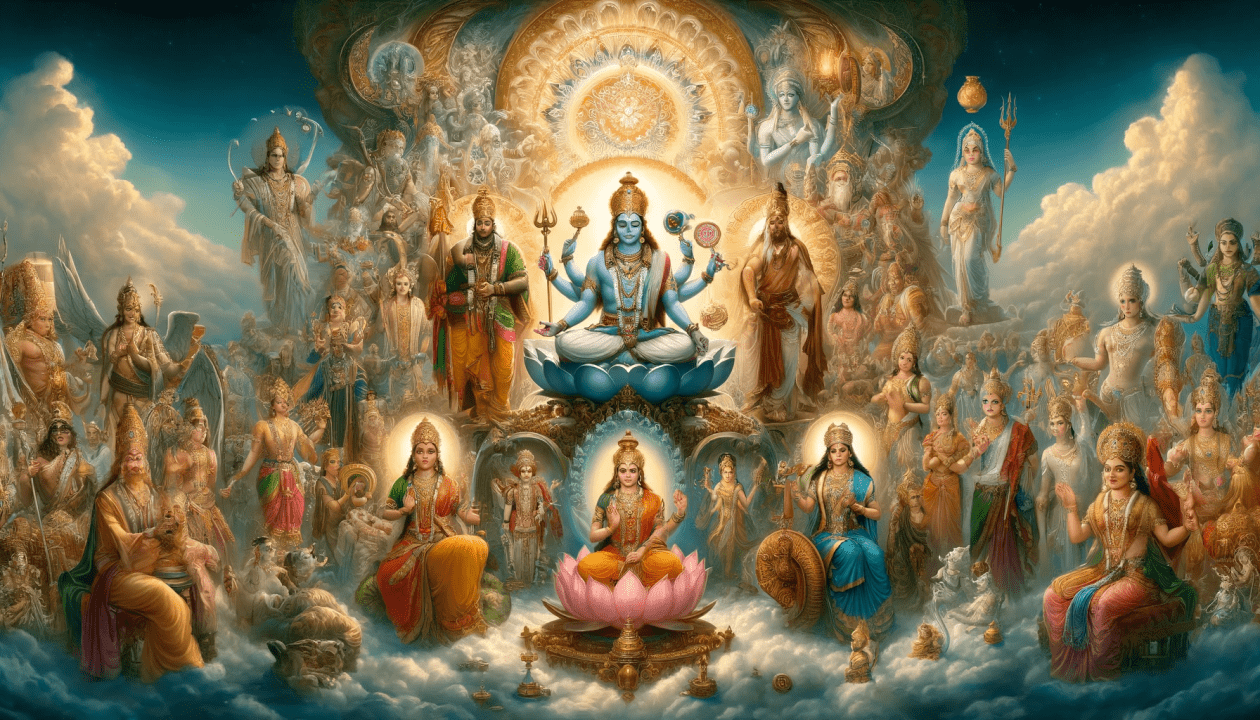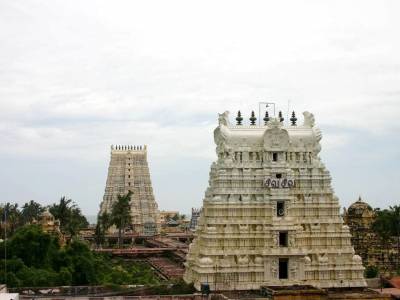Once upon a time, in the ancient land of Bharat, nestled on the southern coast, lay a mystical island known as Rameshwaram. This island was kissed by the waves of the Indian Ocean, and it was here that legends intertwined with the sands of time, giving birth to the revered Ramanathaswamy Temple.

According to Hindu mythology, the temple traces its origins to the epic tale of Lord Rama, the prince of Ayodhya. After defeating the demon king Ravana and rescuing his beloved Sita, Rama sought to atone for the sins of war. Guided by sage Agastya, he realized the importance of consecrating a Shiva Linga in gratitude to Lord Shiva, whom he regarded as one of the most powerful deities. Thus, the foundations of the Ramanathaswamy Temple were laid, marking Rameswaram as a significant pilgrimage site.


As centuries passed, the temple flourished, its structure evolving from humble beginnings to an architectural marvel dazzling pilgrims and visitors alike. The temple complex was adorned with intricate carvings and towering gopurams (gateway towers), each narrating tales of the divine. Devotees traveled from far and wide, drawn by the whispers of divine grace that seemed to echo through the temple’s ancient corridors.

Among the devotees was a humble sculptor named Karthik. He lived in a nearby village and was known for his exquisite craftsmanship. One day, he decided to visit the Ramanathaswamy Temple to seek blessings for his art. Upon entering the temple, Karthik was mesmerized by the beauty around him—the scent of blooming lotuses, the sound of ringing bells, and the glow of oil lamps. He felt an overwhelming sense of peace wash over him as he approached the sacred Shiva Linga.
While praying, Karthik made a wish—to create a masterpiece that would embody the very essence of the divine energy he felt in the temple. Days turned into weeks, and as Karthik returned to his workshop, he poured his heart and soul into sculpting a magnificent statue of Lord Shiva. He envisioned his art as a bridge between the earthly realm and the divine, a tribute to the profound connection he felt during his visit.
As the statue took shape, Karthik could sense the magic of Rameswaram guiding him. Each stroke of his chisel felt divinely inspired as if the spirits of the temple were whispering secrets of artistry into his ears. The villagers often visited him, enchanted by his creation which seemed to come alive with every detail.

When the statue was finally completed, Karthik felt an exhilarating mix of pride and nervousness. He decided to present it at the Ramanathaswamy Temple, hoping that Lord Shiva would bless his work. On the day of the unveiling, a vibrant crowd gathered, their anticipation palpable. As Karthik revealed the statue, a hush fell upon the gathering. The likeness of Lord Shiva captured not just the physical form but the very essence of divinity.
The temple’s priests, moved by the beauty of the statue, declared it a worthy addition to the sanctum. From that day forth, the statue became a part of the Ramanathaswamy Temple, attracting throngs of pilgrims who marveled at Karthik’s dedication and skill.
Years passed, and the temple continued to thrive as a beacon of faith and devotion. The history of the Ramanathaswamy Temple echoed the stories of countless souls who sought solace and enlightenment within its sacred walls. Each visitor added to its rich tapestry of devotion, their prayers and hopes intertwining with the sacred traditions of the past.

And so, the Ramanathaswamy Temple stood not just as a structure of stone and artistry, but as a living testament to the enduring spirit of faith. Generations of pilgrims came and went, each leaving with a piece of the divine in their hearts, forever connected to the stories woven into the very fabric of this ancient temple.
What So Special About Rameshwaram?
The History of the Floating Rocks of Rameshwaram :

Rameshwaram is known for its unique floating rocks, which have captivated the interest of many. These rocks are believed to be remnants of the ancient bridge, known as Adam’s Bridge or Rama Setu, that connects India and Sri Lanka. According to local legends and Hindu epics, the bridge was constructed by Lord Rama’s army to rescue his wife, Sita, from the demon king Ravana.
The intriguing phenomenon of the floating rocks has been the subject of fascination and study, as the stones are said to float due to their unique composition, primarily consisting of lightweight volcanic rock. This historical and cultural significance adds to the allure of Rameshwaram, attracting tourists and pilgrims alike.
In summary, the floating rocks of Rameshwaram are not only a natural wonder but also a vital part of the area’s rich heritage and mythology.
What Make The Rock So Special?

The floating rocks of Rameshwaram hold a special significance for several reasons:
1) Mythological Importance: According to Hindu mythology, these rocks are believed to be part of the bridge, known as Rama Setu, constructed by Lord Rama’s army to rescue Sita. This connection to the epic story of the Ramayana enhances their spiritual and cultural value.
2) Natural Phenomenon: The rocks are primarily made of a type of volcanic rock known as pumice, which is less dense than water, allowing them to float. This unusual characteristic has sparked scientific curiosity and admiration among geologists and visitors alike.
3) Cultural Significance: The floating rocks are integral to the local traditions and beliefs of the people in Rameshwaram. They are often regarded as symbols of faith and devotion, inspiring pilgrims who visit the area to seek blessings.

4) Tourist Attraction: Due to their unique properties and historical importance, the floating rocks attract many tourists and researchers, contributing to the local economy and raising awareness about the region’s heritage.
5) Environmental Insights: The rocks also provide valuable insights into geological processes and the history of the region, making them of interest to environmental scientists and researchers.
Facts And Myths About Rameshwaram Temple:
FACTS:

1) Historical Significance: The temple is one of the twelve Jyotirlingas dedicated to Lord Shiva, making it an important pilgrimage site for Hindus. It is believed to have been built in the 12th century, though its roots trace back to ancient times.
2) Architecture: The temple features stunning Dravidian architecture, with grand gopurams (towering gateways) and intricately carved pillars. The temple is famous for its long corridor, which is one of the longest in the world.
3) Sacred Water Tanks : The temple complex contains several holy water tanks, including the “Agni Tirtham” and “Dhanushkodi,” where pilgrims take ritual baths before performing prayers.
4) Connection to the Ramayana: The temple is associated with the epic Ramayana, as it is believed to be the place where Lord Rama worshipped Lord Shiva after defeating Ravana to seek forgiveness for the killing of a Brahmin.
5) Rituals and Festivals: The temple conducts numerous rituals and festivals throughout the year, drawing thousands of devotees. The most significant festival is the Mahashivaratri, where special prayers and ceremonies are held.
MYTHS:

1) Sita’s Worship: According to some legends, Sita, the wife of Rama, worshipped at this temple to rid herself of sin after her abduction. This belief emphasizes the temple’s significance as a site of forgiveness and redemption.
2) Miraculous Healing: Many devotees believe that simply bathing in the holy tanks and performing rituals at the temple can cure ailments and bring prosperity, thus attributing miraculous healing powers to the sacred waters.
3) The Lingam: There are two lingams (an iconic symbol of Lord Shiva) in the temple — one is believed to have been created by Lord Rama, and the other was consecrated by Ravana. This duality is said to symbolize the relationship between good and evil.



